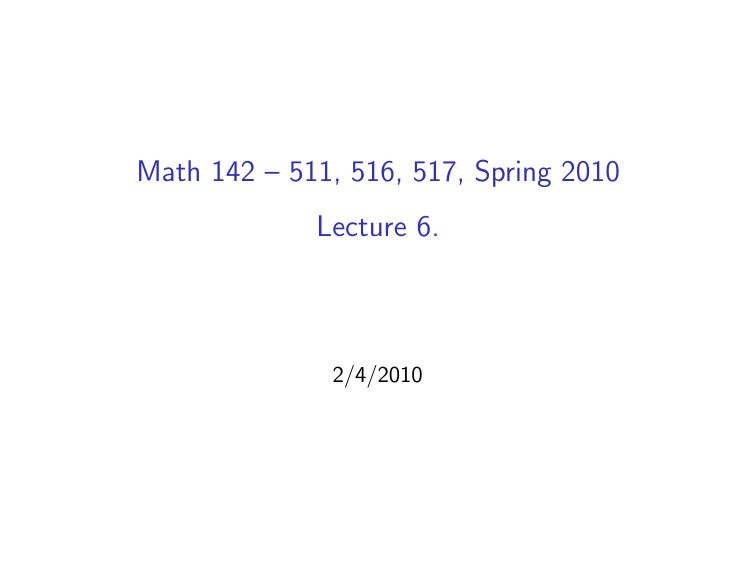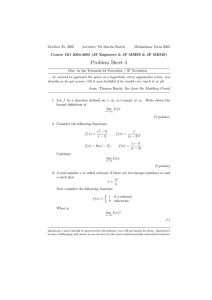Math 142 – 511, 516, 517, Spring 2010 Lecture 6. 2/4/2010
advertisement

Math 142 – 511, 516, 517, Spring 2010 Lecture 6. 2/4/2010 Homework #5 (Section 2-5) Homework #6 (Section 3-1) Homework #7 (Section 3-2) are due Thursday, Feb. 4, 11:55 PM. Week-in-Review on Sunday, Feb. 7, will be held at 11am – 1pm in BLOC 102. Homework #8 (Section 3-3) Homework #9 (Section 3-4) are due Thursday, Feb. 11, 11:55 PM. Chapter 3. Limits and the Derivative Section 3-2 Continuity. Definition. A function f is continuous at the point x = c if 1. lim f (x) exists x→c 2. f (c) exists 3. lim f (x) = f (c). x→c A function is continuous on the open interval (a, b) if f is continuous at each point on the interval. If one or more of the three conditions in the definition fails, the function is discontinuous at x = c. If two functions are continuous on the same interval, then their sum, difference, product, and quotient are continuous on the same interval, except for values of x that make a denominator 0. Solving inequalities by using continuity properties. Sign properties on an interval (a, b). If f is continuous on (a, b) and f (x) 6= 0 for all x 6= 0 for all x in (a, b), then either f (x) > 0 for all x in (a, b) or f (x) < 0 for all x in (a, b). Constructing sign charts. Given a function f . Step 1. Find all partition numbers. That is, (A) Find all numbers such that f is discontinuous. (B) Find all numbers such that f (x) = 0. Step 2. Plot the numbers found in step on a real-number line, dividing the number line into intervals. Step 3. Select a test number in each open interval determined in step 2, and evaluate f (x) at each test number to determine whether f (x) is positive (+) and negative (–) in each interval. Step 4. Constructing a sign chart, using the real-number line in step 2. This will show the sign of f (x) on each open interval. Example 1. Solve the inequality x 2 + 5x < 0. x −3 Section 3-3 Infinite limits and limits at infinity. If a function f either increases or decreases without bound as x approaches a, we say that the lim f (x) = ∞. x→a Example 2. Find each of the following limits 1 , x→2 x − 2 1 . (b) lim x→2 (x − 2)2 (a) lim Definition. The vertical line x = a is a vertical asymptote for the graph of y = f (x) if f (x) → ∞ or f (x) → −∞ as x → a+ or x → a− . If f (x) = n(x)/d(x) is a rational function, d(c) = 0 and n(c) 6= 0, then the line x = c is a vertical asymptote of the graph of f . Example 3. Find vertical asymptotes of the function 3x + 2 . 3 x + x 2 − 2x The symbol ∞ also can be used to indicate that an independent variable is increasing or decreasing without bound. We write x → ∞ to indicate that x increases without bound through positive values and x → −∞ to indicate that x decreases without bound through negative values. Definition. A line y = b is a horizontal asymptote of the graph of y = f (x) if either lim f (x) = b or lim f (x) = b. x→∞ x→−∞ Limits of power functions at infinity. If p is a positive real number and k is any real constant, then k k 1. lim p = 0 2. lim p = 0 x→∞ x x→−∞ x 3. lim kx p = ±∞ x→−∞ 4. lim kx p = ±∞ x→∞ provided that x p is a real number for negative values for x. The limits in 3 and 4 will be either −∞ or ∞, depending on k and p. Limits of polynomial functions at infinity. If p(x) = an x n + an−1 x n−1 + ... + a1 x + a0 , an 6= 0, n ≥ 1 then lim p(x) = lim an x n = ±∞ x→∞ x→∞ and lim p(x) = lim an x n = ±∞. x→−∞ x→−∞ Each limit will be either ∞ or −∞, depending on an and n. Polynomials of degree 1 or greater never have horizontal asymptotes. Limits of rational functions at infinity. an x n + an−1 x n−1 + . . . + a1 x + a0 an x n = lim = x→∞ bm x m + bm−1 x m−1 + . . . + b1 x + b0 x→∞ bm x m an bm , if n = m 0, if n < m ∞, if n > m lim A rational function can have at most one horizontal asymptote. Example 4. Evaluate the limit. 7x 3 + 4x x→∞ 2x 3 − x 2 + 3 (a) lim (b) lim x3 + 4 x→∞ x − 3 2 − 3x + 1 (c) lim x 2x +3 x→∞ Example 5. Find all the asymptotes of the function f (x) = 2x 2 + 3x − 2 . x2 − x − 2






